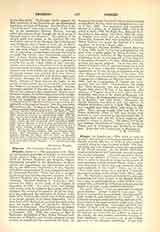

Frigolet, Abbey of.—The monastery of St. Michael was founded, about 960, at Frigolet, by Conrad the Pacific, King of Arles, on one of the numerous hills which lie between Tarascon and Avignon, France. Successively occupied by the Benedictines of Montmaj our, the Augustinians, the Hieronymites, and fin-ally by the Reformed Augustinians, it was, together with all the monasteries in France, suppressed and sold by the French Republic. From that time it changed hands frequently, and was acquired, at length, by Rev. Edmund Boulbon, who purchased it from Rev. T. Delestrac. Edmund Boulbon, b. January 14, 1817, entered the Abbey of Our Lady of La Trappe at Biiquebec, in 1850. Of a robust faith, and burning with zeal for souls, he wished to lead a more active life. Acting on the advice of his superiors, he left the Trappists and undertook the restoration, in France, of the Order of St. Norbert, the constitution of which seemed to be better adapted to his active disposition. On June 6, feast of St. Norbert, he received the white habit from the hands of Msgr. de Gassignies, Bishop of Soissons, at Premontre. Pius IX approved the project in an audience which he granted to Father Edmund, December 4, 1856. With the consent of Msgr. de Chalandon, Archbishop of Aix, Father Edmund took possession of Frigolet, and, having admitted several novices, he commenced the community life there. In honor of Our Lady Conceived without Sin he erected a magnificent church, which was solemnly consecrated on October 6, 1866. The monastery was canonically erected as a priory on August 28, 1868; and as an abbey in September, 1869, the Right Rev. Edmund Boulbon being its first abbot. On November 8, 1880, the abbey of Frigolet was seized and the religious expelled. Eventually, however, they were permitted to return. Abbot Boulbon was spared the miseries of a second expulsion, for he died March 2, 1883.
His successor, Paulinus Boniface, named abbot on June 10, 1883, undid by his bad administration the good work so nobly begun by Abbot Boulbon; but after a canonical visitation by Msgr. Gouthe-Soulard, Archbishop of Aix, he was deposed, and the direction of the abbey entrusted to the Rev. Denis Bonnefoy, a prudent and saintly religious. Up to this time, the Abbey of Frigolet, with the priories founded by it, had formed as it were a separate congregation with an organization of its own, having no connection with the other abbeys or the general chapter of the order. This state of affairs was remedied by a decree of the Sacred Congregation of Bishops and Regulars, dated September 17, 1898; and the congregation of Frigolet was incorporated with the order. Unfortunately, the Right Rev. Denis Bonnefoy, who was made abbot on March 21, 1899, died on September 20 of the same year. The religious of Frigolet chose for their abbot Godfrey Madelaine, then prior of the Abbey of Mondaye, Calvados, France, the distinguished author of “L’histoire de S. Norbert” and other books. Meanwhile the French Republic had framed new laws against all religious institutions, and on April 5, 1903, the religious, expelled from their abbey, took refuge in Belgium. There, having bought what was left of the former Norbertine Abbey of Leffe near Dinant, they restored it; and continued in the conventual life, in the hope that some day the fathers might be permitted to return to France. The Abbey of Frigolet had founded the priories of Conques and Etoile in France, and of Storrington and Bedworth in England. It has also sent missionaries to Madagascar.
F. M. GEUDENS

